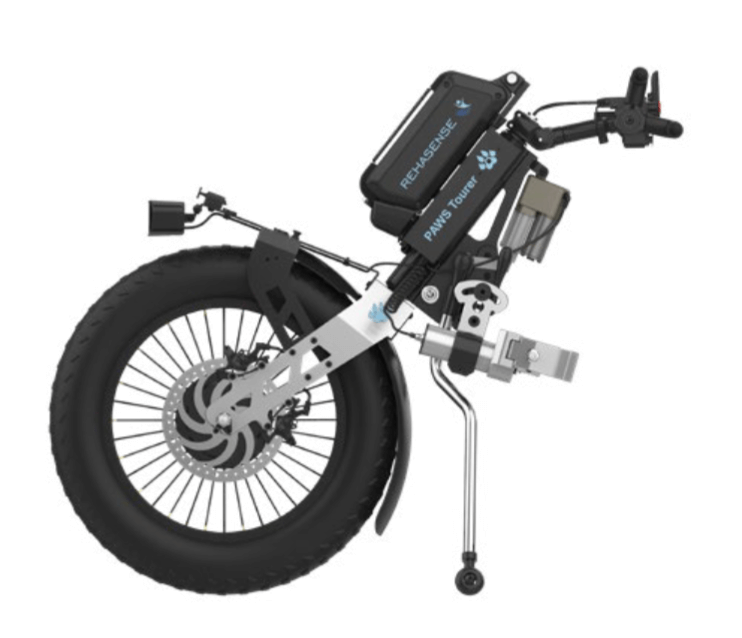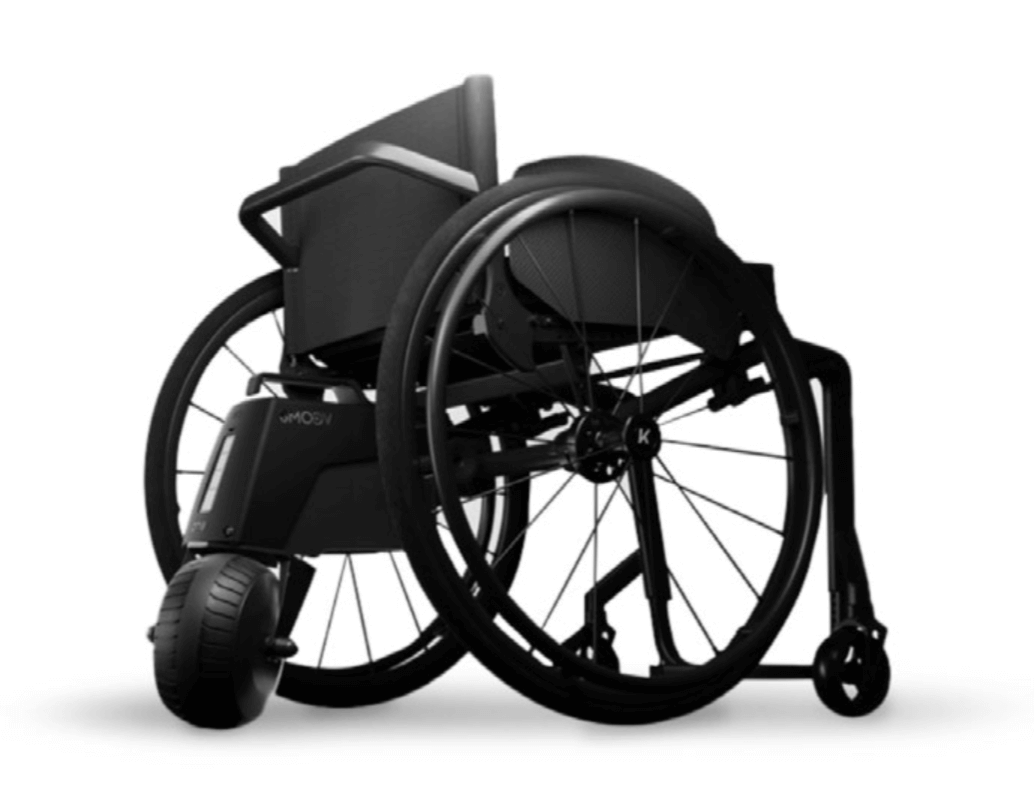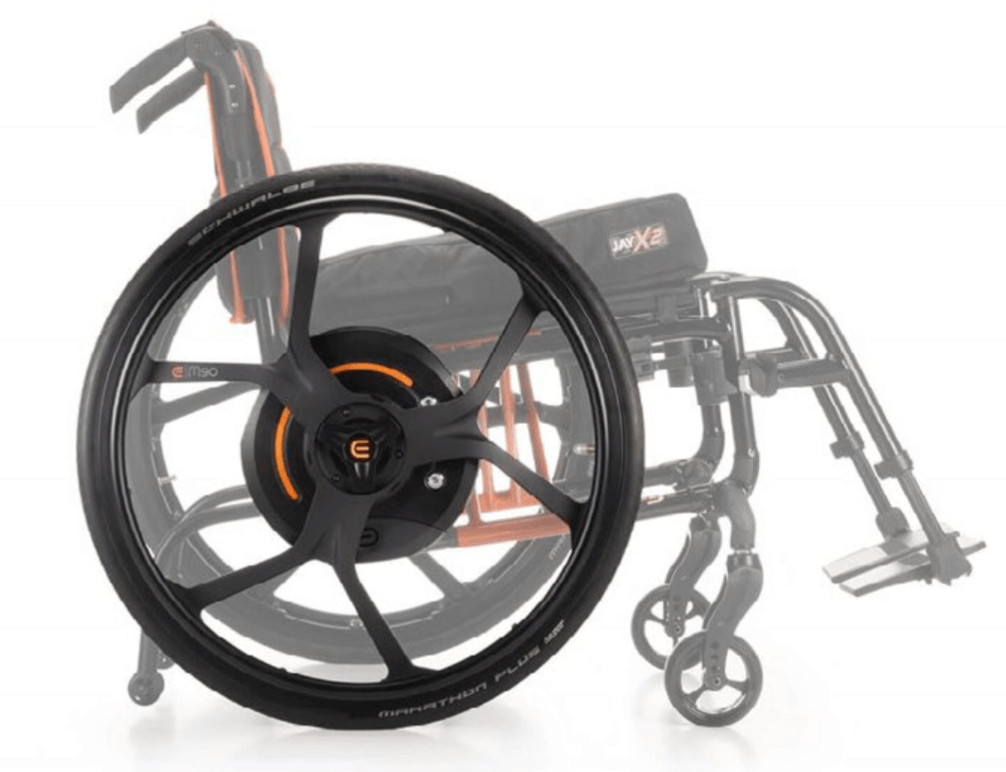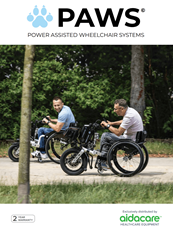
POWER ASSIST DEVICES – GENERAL
Power assist devices or motor attachments can be added to a manual wheelchair to provide powered assistance. Power assist devices may be prescribed:
• For people who rely on a wheelchair for their mobility
• While lightweight custom scripted manual wheelchairs provide independence for those who can self-propel, even with the most advanced manual wheelchair provision, there may be times when additional assistance is needed to provide extra power, speed, and range
• To further enhance the user’s independence, perhaps where provision of a full power wheelchair is not the best/most practical option
• To help reduce strain on shoulders and upper limbs, which preserves independent function, joint protection and energy conservation
• Depending on the power assist device, it can assist in navigating different types of terrain with ease.
Assessment and trial are key to determine the correct style of power assist device for each person to ensure compatibility with abilities, transfers, environment and transport. The user will need to have cognitive abilities allowing them to pay attention and monitor speed in busier environments.
The safe working load of these devices need to consider the weight of the user and the wheelchair.
Power assist devices can generally be retrofitted to an existing manual wheelchair, but there can be some exceptions. For example, when adding the device takes the system over the safe working load, or the wheelchair needs a different configuration to be compatible with the required power assist device.
There are three main types of powered add-on:
• Front Pull
• Rear Push Assist
• Power Wheel Add-on

POWER ASSIST DEVICES – FRONT PULL
Power assist devices that clamp onto the front of an active use wheelchair, and provide handlebars with controls.
Some options have a fully electric system that lifts the front casters off the ground, creating a three wheeled bike style device with contact to the ground through the rear wheels and front wheel.
Different size drive wheels are available for different environments / terrains.
PROS
• Excellent for outdoor use as it allows for easier negotiation of uneven terrain and inclines
• Increased speed and range – can travel long distances (approx. 40 km) and come with a variety of speed modes – the max of which is 10 km/hour so similar performance as a mobility scooter
• Aesthetically it looks like a trike and not a disability aid
CONSIDERATIONS
• Some devices require the wheelchair to have a fixed front end - can the user transfer in and out without swing-away hangers/footplates?
• How easy is it to attach the unit – does the user have the required strength and hand function? Is a Quad/ tetra hand control required?
• Increases the overall footprint of the wheelchair, creating a longer system that has a large turning circle – may not be suitable for indoor use
• Due to their overall size and weight, not easily transported along with the manual wheelchair – can weigh up to 29 kg depending on make and model. Lighter models at around 20 kg are generally suitable for tarmac roads only
• Suitability of the MWC frame and effect of front pull device e.g. wear and tear on the wheelchair frame, tyres and rear wheel axles
FRONT PULL POWER ASSIST DEVICES
PAWS Tourer, PAWS Cruiser, PAWS City, Sunrise Medical Empulse F55, Alber e-pilot

POWER ASSIST DEVICES – REAR PUSH ASSIST
Power assist device that clips / mounts onto the rear of the wheelchair, or clamps directly onto the wheel, and gives additional force to “push” the manual wheelchair forwards.
Gives assistance to manage distance and slopes more easily, reducing the incidence of upper limb strain and fatigue, allowing the user to go further with less effort.
PROS
• Generally, very compact and don’t impact the overall size of the wheelchair too much, so good manoeuvrability indoors or outdoors
• Easy to transport, weighing only around 6kg. Can be compatible with airline travel, depending on style of battery and if it is removable
• Most devices can be used across both folding or rigid frame manual wheelchairs, but depending on the style of device will have different mounting systems
CONSIDERATIONS
• Depending on the device selected, power wheels can make the wheelchair slightly wider due to increased depth of the wheel hub. If anti tips are a requirement, then this slightly increases the length too
• For systems that enhance the push, the user must be able to self-propel consistently with adequate strength and control, and must be able to hold the hand rims to control speed and for braking
• The motorised hub in the wheel does add extra weight to the wheelchair system, so consider transportation – do the wheels need to be removed and how often?
• Some wheels have limited tyre options – solid only, how will this affect the quality of the ride?
• Although the addition of some power wheels gives similar performance to that of a powered wheelchair, the system still has a manual wheelchair frame and wheels, so generally only compatible with flat level surfaces
• Max speed – about 6 km/h dependent on the device. Range per charge varies 15km – 27km
• Safe Working Load – Not only do you need to include the user and the wheelchair, on more complex tilt in space chairs may also need to consider ventilators, suction and oxygen
POWER WHEEL ADD-ON POWER ASSIST DEVICES
Alber - Emotion wheels, E-Fix | Sunrise Medical - Empulse M90, Quickie Ixpress. Quickie Xtender

POWER ASSIST DEVICES – POWER WHEEL ADD-ON
Motors are incorporated into rear wheels, which then provide forward propulsion.
Some options allow users to still self-propel. The power wheel add-on enhances their push, multiplying the force that is applied to the hand rim. Other options provide an incorporated motor, which acts as a drive wheel and is controlled with either a joystick or rear mounted attendant control.
PROS
• These wheels replace the standard manual wheelchair wheel, so aesthetically the wheelchair doesn’t look much different
• Minimal impact on the overall footprint of the wheelchair, so generally the system stays compact and manoeuvrable
• Able to be mounted to a folding or rigid manual wheelchair, so system is easy to break down and transport
• Power wheels are available in different wheel sizes – 24” more for active self-propellers with 16” being used for attendant-controlled systems that can mount to tilt in space wheelchairs
CONSIDERATIONS
• Best suited for harder ground and pavement. Depending on the terrain, can lose traction on soft surfaces like grass and dirt
• Some sit under the wheelchair, mounting from the rear axle, while others mount above the rear wheel – need to consider safety and centre of gravity when additional weight is added to the rear of the wheelchair
Controls:
• Some can be controlled using Bluetooth paired dial controls or even a smartwatch, does the user have cognitive ability and reaction time to safely control the device?
• This also still requires the users to physically assist with steering and braking, do they have adequate upper limb strength and function?
• Some options have a joystick control, so much less physical effort is required
• Depending on the style of device and mounting, not everyone will be able to detach and reattach independently – strength, hand function and position of mounting?
• For the clamp to wheel style power assist device, specific tyres are recommended to maintain safety and longevity – potential of additional costs if requiring regular replacement
• Max speed 6-10 km/h dependent on the device. Range per charge varies between 7-20 km
REAR PUSH POWER ASSIST DEVICES
Permobil Smartdrive, Alber Smoov One, Empulse R90, Benoit Systemes Lightdrive, Todo Drive




































































































